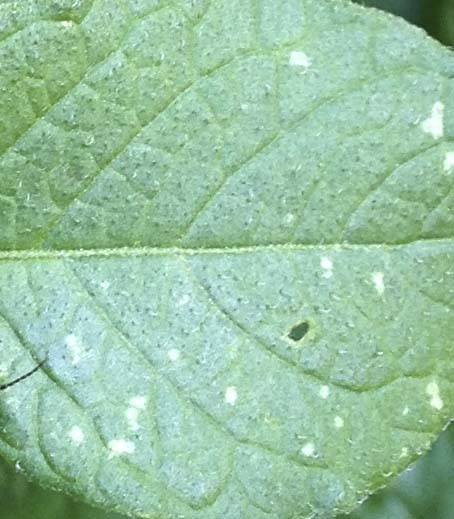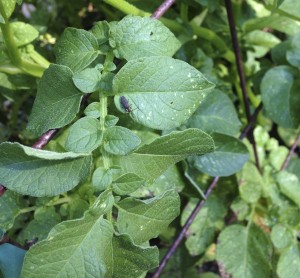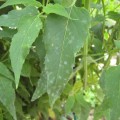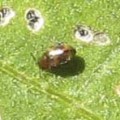Leafhoppers seem to be the bain of my existence…well, not really – but they sure complicate my veggie gardening. They would only be mildly annoying, if it weren’t for the diseases they spread.
Physical Description
very small insects, ranging from 1/12 – 1/8 inches long (2-3 mm). They are wedge-shaped, with narrow bodies that are broadest at the head and taper to the rear. They look a lot like a very very tiny cricket, and are related to the cicadas. They are colored light green, pale yellow, or brown. Some have bright bands of color on the wings. Nymphs are often white. The aster, or 6-spotted, leafhopper has 6 pairs of black spots on the front of the head. Click here to see images from Google.
They live mostly on the underside of leaves, sucking sap from the plant, leaving stippling or mottling on the top-side of the leaf. Most species feed on the phloem of plants, removing only small amounts of sap, while excreting some honeydew. Several leafhoppers just eat the upper cell layers of the leaf (mesophyll, parenchyma), where they leave white flecking wounds. These leafhoppers often excrete dark spots like lace bugs and some thrips or plant bugs. Empoasca genus leafhoppers can injure the vascular system, which results in hopperburn. This is what killed my potatoes, I think. There are also some leafhoppers that are known as “sharpshooters”because they flick small droplets during excretion, which is seen as a fine spray. Besides this damage to plants, their biggest offense is the transmission of disease: both viruses (curly top), phytoplasmas (aster yellows, ash yellows), and bacteria (bacterial leaf scorch, Pierce’s disease of grape). See below for a list of the different symptoms of having leafhoppers; also, see below for info on these diseases.
They are very quick and jump off the plant as soon as you get near or rustle the plant. The nymphs are wingless, though, and therefore crawl in a crab-like manner. They are often seen running sideways or hopping. Rustle a plant and if you see a bunch of very small insects jump off and fly to a neighboring plant, then you pretty much know you’ve got ’em.
They lay their eggs as small groups in leaves and stems, under the surface, usually in veins or small twigs. They will hatch in 10-14 days. The nymphs take several weeks to develop. They can fit in 2-5 generations per year and can overwinter as either adults or eggs, but not nymphs.
There are more than 2500 species of leafhoppers in North America. My potatoes, parsley, brassicas, and squash leaves, along with dahlias and other ornamentals, and strawberries were fiercely attacked last summer by these pesky little buggers. The books all state that significant plant injury is rare, but they ravaged my garden. Potatoes were completely sacked, and the dahlias looked sad. The injuries on the dahlias looked a lot like spider mite damage, but there were no spider mites & tons of leafhoppers. Maybe it was just a really bad year for leafhoppers…or wait, a good year for leafhoppers, a bad year for the gardener!
Species & Taxonomy
Phylum: Arthopoda
Class: Hexapoda
Order: Homoptera
Homoptera includes aphids, psyllids, whiteflies, scales, cicadas, leafhoppers, and others. They undergo a simple metamorphosis. Most families have immature stages which roughly resemble the adult form, except the absence of wings; however, some have unusual forms. The nymph stage of leafhoppers have no wings and look exactly the same as the adult.
Specific Leafhopper Species of Note:
- Apple Leafhopper (Empoasca maligna) – produces white flecking injuries
- Aster Leafhopper, aka Six-spotted Leafhopper (Macrosteles quadrilineatus)
- Beet Leafhopper (Circulifer tenellus) – spreads curly top virus
- Ceratagallia abrupta
- Eastern Grape Leafhopper (Erythroneura comes) – very similar to the Western Grape Leafhopper relegated to the eastern US
- Edwardsiana australis – occurs on mountain ash
- Edwardsiana commisuralis – common western species; injuries similar to rose leafhopper on dogwood & alder
- Edwardsiana hippocastani – occurs on elm
- Erythroneura gleditsia – feeds on black locust, Aesculus species and hawthorn
- Erythroneura lawsoniana – feeds on sycamore
- Intermountain Leafhopper (Empoasca filamenta) – produces white flecking injuries to potato & bean plants, but do not cause hopperburn.
- Maple Leafhopper (Alebra albostriella) – produces stippling on several trees and shrubs, including various maples, American elm, basswood, oak, beech, hickory, hawthorn and sumac; produces only one generation per year; populations peak around late spring in the East and midsummer in central California; overwintering eggs are inserted into twigs.
- Mountain Leafhopper (Colladonus montanus)
- Potato Leafhoppers, Empoasca fabae, (don’t know if mine were these specific buggers) are migratory and cause hopperburn by injecting a toxin as they feed. They don’t just attack potatoes, though. Beans and other legumes, along with raspberries, young birch, maple and apple trees, are common hosts. They are pale green, roughly 1/8″ long, typical leafhoppers. Distinction between this leafhopper & other leafhoppers can not be easily made, except by experts. Cold winters will kill them off, so they spend the cold months in the south, migrating northward in May or early June. My books say these are restricted to eastern North America, “only infrequently being found as far west as Wyoming and Colorado”, but I am pretty certain that hopperburn is what killed my potatoes here in Redding, CA. I took leaf samples down to our agricultural extension office and they identified leafhoppers to be my problem…not specifically the Potato Leafhopper, though. Hopperburn symptoms are listed under Symptoms.
- Privet Leafhopper (Fieberiella florii)
- Rose Leafhoppers (Edwardsiana rosae) leave a coarse, whitish mottling on the leaves’ upper surfaces. For some reason (maybe because they are more protected from wind & rain) roses that are against a wall are more heavily infested. They feed on the mesophyll. Damage occurs early in the season, then the leafhoppers go off to their summer hots. They lay their fall-time eggs in the stems and canes and occasionally these wounds let other pathogens in to harm the rose. The eggs survive winter and develop into pimple-like swellings. Eggs hatch in early spring, then the nymphs move to the underside of the foliage. All nymphal stages can be completed in 2-3 weeks. Summer-time eggs are laid in large veins and petioles of leaves. Two additional generations will complete in the summer. leading to 3 waves of peak nymph numbers: early June, late July/early August, and mid-September. These leafhoppers are more of a pale yellow than a green, and go all the way to creamy white. the wingless nymphs also exhibit reddish eyes, which turn to white as they mature. Dark spots on the back of the nymph is how to tell these apart from the apple leafhopper. Unlike other leafhopper nymphs, these ones cannot move sideways.These leafhoppers also love apple, dogwood, oak, hawthorn, poplar, elm and maple. They overwinter on Rosa & Rubus species.
- Scaphytopius acutus
- Scaphytopius irroratus
- Six-spotted Leafhopper, aka Aster Leafhopper (Macrosteles quadrilineatus)
- Southern Garden Leafhopper (Empoasca solana) – produces white flecking injuries to potato. lettuce & bean plants in southern states, but do not cause hopperburn.
- Threebanded Leafhopper (Erythroneura tricincta) – may be found on grape, Virginia creeper, and apple in the east
- Variegated Leafhopper (Erythroneura variabilis) – grape leafhopper, very similar to the Western Grape Leafhopper, in Southern California
- Virginiacreeper Leafhopper (Erythroneura ziczac) – common in the high Plains and Rocky Mountain regions where it likes to eat grape, Virginia Creeper, elm, and Boston Ivy.
- Western Grape Leafhopper (Erythroneura vulnerata) – important pest of vineyards in western states; pests overwinter as adults under garden debris, near previously infested plants; adults emerge when temperatures hit the mid-60s and fly to vines to feed as new growth emerges; eggs are laid after several weeks just underneath the leaf surface. The eggs appear as a small bubble when observed closely. Eggs hatch in 1-2 weeks; nymphs start feeding on the mesophyll of the cells on the lower leaf surface; mature in about 3 weeks. 3-5 generations can be produced annually, depending on location…which means they can be present on plants continuously, as long as leaves remain. In the fall the adults disperse to get under cover for the winter.
- Western Potato Leafhopper (Empoasca abrupta) – produces white flecking injuries to potato & bean plants, but do not cause hopperburn.
- White Apple Leafhopper (Typhlocyba pomaria) – looks identical to the rose leafhopper; whitish flecking/stippling on leaves; apple, cherry, peach, prune & hawthorns affected; nymphs are usually translucent white, occasionally yellow; two generations are produced, but overlap so adults are almost always present from late May through October; major pest of apple orchards in North America; damage plants by removing chlorophyll and excreting dark droplets that spot fruit
- Ziczac Leafhopper (Erythroneura ziczac)
Plants Affected
- anything and everything in the Aster family
- Apple Trees
- Baby’s Breath (Gypsophila)
- Beans
- Beets
- Birch Trees
- Carrots
- Chrysanthemums
- Coreopsis
- Dahlias
- Dianthus
- Dill
- Elms
- Grape
- Lettuce
- Maples
- Peas
- Petunias
- Potatoes
- Raspberry
- Rhubarb
- Roses
- Tulips
Plants Unaffected
Geographical Range
Diseases Transmitted by Leafhoppers
- Ash Yellows
- Aster Yellows
- Bacterial Leaf Scorch
- Curly Top
- Elm Yellows
- Hopperburn
- Pierce’s disease of grape
Signs & Symptoms
Whole Plant
- wilting
- stunted growth
- bushy habit because of branching, above (Aster Yellows)
- internodal space on stems or branches shrink (Aster Yellows)
Leaves
- when rustled, lots of little specks will jump off
- pale mottling on upper side of leaf surface, “pale flecking wounds”
- tiny black spots, which are leafhopper excrement
- Hopperburn: marginal areas of the leaf turn yellow then brown and look burned (esp potato leafhopper)
- leaves discolored & puckered or curled (esp potatoes; more subtle in beans)
- rose leaves tend to have more contrast with the mottling, and the leaf surface feels coarse
- new leaves are yellow and spindly, with the petiole elongated and the blades dwarfed (Aster Yellows)
- Veins turn yellow (Aster Yellows)
- 6 or more leaves will come out of the same node where only 2 are expected (Aster Yellows)
- stunted (Curly Top)
- Crinkled (Curly top)
- Bushy growth (Aster Yellows)
- Young leaves yellow (Aster Yellows)
- Grape leaves get pale or white stippling along the leaf veins; when heavily infested, the leaf will turn yellow or brown and drop from the vine
Flowers
- flowers drop
- deformed (Aster Yellows)
- buds don’t open (Aster Yellows)
- flower stays a yellow-green color when it opens; this is called virescence. (Aster Yellows)
Fruit
- bean pods drop
- skin becomes wart like (Aster Yellows)
- loss of flavor (Aster Yellows)
- fruit ripens early, but with no flavor (Aster Yellows)
Roots/Tubers
How to Positively Identify
Treatment
Prevention & Control
Cultural Controls:
Habitat:
Temperature & Humidity:
Leafhoppers love warm, dry weather, so shading & misty during hot dry spells helps keep populations under control
Mulching & Cultivation Practices:
- Plant MLO Resistant varieties: carrots, tomatoes, and potatoes have resistant varieties.
- Organic mulch, replaced several times per year
- Aluminum foil mulch will control aphids, leafhoppers & thrips on cabbages and peppers. Needs to be removed later in the summer to prevent heat damage from the reflected sunlight. You can just lay strips of foil in between the plants.
Natural Enemies & Biological Controls
Insects:
- Bigeyed Bugs
- Parasitic Wasps
- Predatory Flies
Animals:
Reptiles:
Barriers
- Floating rowcover (cheese cloth: 22 threads per inch; wire: 18strands per inch)
Traps
-
- Blacklight traps
- Yellow sticky paper
Sprays & Dusts
- Water Sprays: Dislodge nymphs with blasts of water at the underside of the leaves. Adults just jump around, avoiding the blast, but the ones that are hit, are sufficiently damaged so they can’t feed anymore. this is good for all soft-bodied plant-eating pests like aphids, thrips and spider mites. You want a forceful spray that will cover a large area. Keep the stream moving back and forth, to not damage foliage or flowers. Make sure to attack the undersides of the leaves, too. The negative aspect of this method is with dangers of overwatering or hurting plants physically. Stay away from seedlings, since they are tender. Avoid during humid or wet weather so you don’t encourage fungal diseases. In order to not burn the foliage in hot sunlight, spray in the early morning or at dusk.
- insecticides that work on aphids work on leafhoppers, although a direct hit is often required, which adults are good at avoiding.
- Neem Oil
- Insecticidal Soap (spray in the evening)
- Insecticidal Soap & Alcohol Mix:
- 1 Tablespoon 70% isopropyl alcohol
- 1 pint insecticidal soap
- spray once every 3 days for 3 times.
- spray or dust with pyrethrin if insecticidal soap doesn’t work
- make sure to get the underside of the leaves where the nymphs are
- Garlic Oil
- Diatomite, or diatomaceous earth: sprinkle on foliage and in a band on soil around the plant (avoid sprinkling on flowers) when wet. kills all soft-bodied crawling insects, like aphids, caterpillars, and thrips. Since it can irritate mucosal membranes, wear a mask when sprinkling. Pool grade diatomaceous earth is treated with chemicals, so don’t use in the garden. One big negative with the use of DE is that it is non-selective. it will kill beneficial insects as well as the pests, so it should only be applied where there is a problem. Can also be painted on tree trunks as a slurry (mix DE with dish soap and water to make a thick slurry).
- pyrethrins
- rotenone or sabadilla as last resort
Sources:
- Rodale’s Vegetable Garden Problem Solver
- Garden Insects of North America
- Organic Pest & Disease Control







The negative aspect of this method is with dangers of overwatering or hurting plants physically. over watering